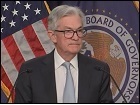By Pam Martens and Russ Martens: October 24, 2023 ~
Last Friday, the Federal Reserve published its Financial Stability Report, which takes a detailed look at U.S. financial stability through the second quarter of this year. Although the Fed does its best to put a rosy glow on the outlook, it’s not a pretty picture.
We found the most disturbing sentence in the report to be the following:
“Overall, estimated runnable money-like financial liabilities increased 3.4 percent to $20.3 trillion (75 percent of nominal GDP) over the past year.”
Given that a handful of banks this past spring, with combined liabilities of less than $1 trillion, caused a full blown banking panic and bank runs, the Fed’s figure of $20.3 trillion of “runnable” money is not a comforting thought. The Fed elaborates as follows:
“The banking industry maintained a high level of liquidity overall, but some banks continued to face funding pressures; meanwhile, structural vulnerabilities persisted in other sectors engaged in liquidity transformation.
“The banking industry overall maintained a high level of liquidity since the May report. Funding risks for most banks remained low, and large banks that are subject to the liquidity coverage ratio (LCR) continued to maintain ample levels of HQLA [High Quality Liquid Assets] given the risk of their funding structures. That said, banks that came under stress and experienced large deposit outflows in March continued to face funding pressure. Since March, volatility has abated and deposit outflows have largely stabilized—owing, in part, to actions by the Department of the Treasury, the Federal Reserve, and the Federal Deposit Insurance Corporation—but these banks nonetheless continued to face challenges navigating changes in depositor behavior, higher funding costs, and reduced market values for investment securities.
“Prime MMFs [Money Market Funds] and other cash-investment vehicles remained vulnerable to runs and, hence, contributed to the fragility of short-term funding markets. In addition, some cash-management vehicles, including retail prime MMFs, government MMFs, and short-term investment funds, maintained stable net asset values (NAVs) that make them susceptible to sharp increases in interest rates. The market capitalization of the stablecoin sector continued to decline, but the sector remained vulnerable to liquidity risks like those present in other vehicles that attempt to substitute for cash. Some open-end bond mutual funds continued to be susceptible to large redemptions because they must allow shareholders to redeem every day even though the funds hold assets that can face losses and become illiquid amid stress. Life insurers continued to face liquidity risk owing to heavy reliance on nontraditional liabilities in combination with an increasing share of illiquid and risky assets on their balance sheets.”
The mention of life insurers with “nontraditional liabilities” and “illiquid and risky assets on their balance sheets” is a particularly sensitive subject for the Fed, which is supposed to be supervising the global systemically important banks (GSIBs) to make sure they don’t spread their contagion through the U.S. financial system in a replay of 2008. On September 16, 2008, one day after Lehman Brothers made its bankruptcy filing, the U.S. government had to nationalize American International Group (AIG), one of the largest life insurers in the world.
AIG received a taxpayer backstop of $185 billion but the bailout of AIG was in reality a backdoor bailout of the global banks on Wall Street who had used AIG as a counterparty on their casino-like Credit Default Swaps and for securities loans – neither of which AIG could make good on. (Something that the Fed’s bank examiners apparently missed.)
It was eventually revealed that major Wall Street banks, foreign banks and hedge funds received more than half of AIG’s bailout money ($93.2 billion). Public pressure eventually forced AIG to release a chart of these payments.
The chart linked in the paragraph above shows that the largest beneficiaries of the AIG bailout were as follows: Goldman Sachs received $12.9 billion; the French global bank, Societe Generale, received $11.9 billion; Merrill Lynch and its U.S. banking parent, Bank of America, received a combined $11.5 billion; the British bank, Barclays, received $8.5 billion; and Citigroup, which was secretly receiving $2.5 trillion in cumulative loans from the Fed between December 2007 to July 2010, got another backdoor bailout of $2.3 billion from the rescue of AIG.
Since 2008, the Fed’s approach to both supervision of the mega banks and financial stability is to have no restraints on the amount of money it can create electronically to bail out the bad boys on Wall Street in an effort to cover up its own incompetence as a bank supervisor. (See Related Articles below.) That’s not a sustainable plan for a stable financial system for the United States of America.
Related Articles:
Gallup Poll: Confidence in U.S. Banks Stood at 60 Percent in 1979. Today, It Stands at 26 Percent.
These Are the Banks that Own the New York Fed and Its Money Button


